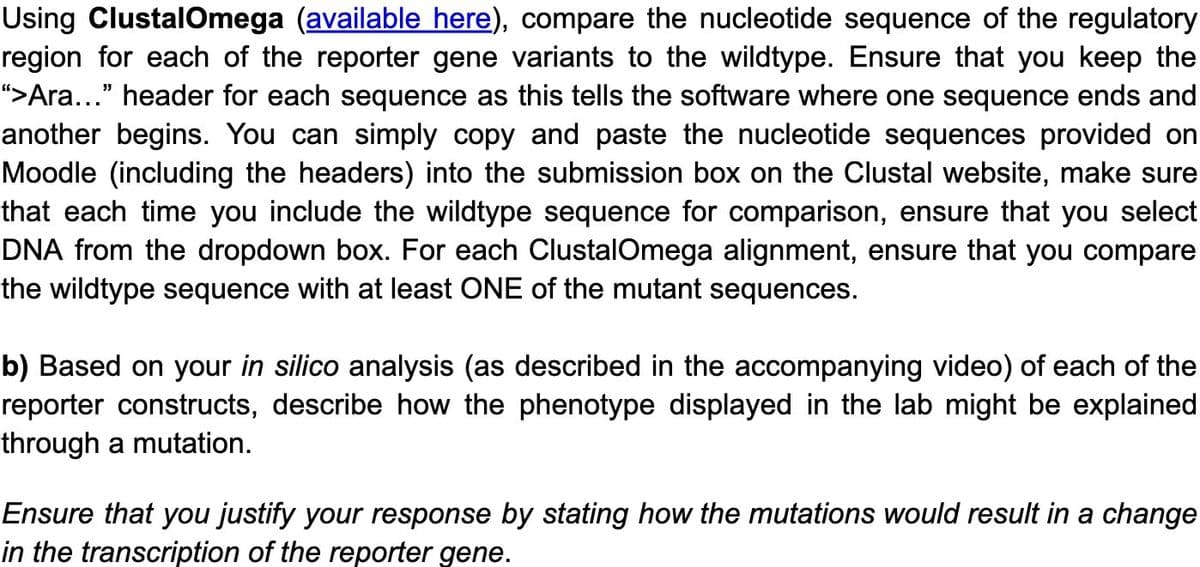Using ClustalOmega (available here), compare the nucleotide sequence of the regulatory region for each of the reporter gene variants to the wildtype. Ensure that you keep the “>Ara..." header for each sequence as this tells the software where one sequence ends and another begins. You can simply copy and paste the nucleotide sequences provided on Moodle (including the headers) into the submission box on the Clustal website, make sure that each time you include the wildtype sequence for comparison, ensure that you select DNA from the dropdown box. For each ClustalOmega alignment, ensure that you compare the wildtype sequence with at least ONE of the mutant sequences. b) Based on your in silico analysis (as described in the accompanying video) of each of the reporter constructs, describe how the phenotype displayed in the lab might be explained through a mutation. Ensure that you justify your response by stating how the mutations would result in a change in the transcription of the reporter gene.
Using ClustalOmega (available here), compare the nucleotide sequence of the regulatory region for each of the reporter gene variants to the wildtype. Ensure that you keep the “>Ara..." header for each sequence as this tells the software where one sequence ends and another begins. You can simply copy and paste the nucleotide sequences provided on Moodle (including the headers) into the submission box on the Clustal website, make sure that each time you include the wildtype sequence for comparison, ensure that you select DNA from the dropdown box. For each ClustalOmega alignment, ensure that you compare the wildtype sequence with at least ONE of the mutant sequences. b) Based on your in silico analysis (as described in the accompanying video) of each of the reporter constructs, describe how the phenotype displayed in the lab might be explained through a mutation. Ensure that you justify your response by stating how the mutations would result in a change in the transcription of the reporter gene.
Human Heredity: Principles and Issues (MindTap Course List)
11th Edition
ISBN:9781305251052
Author:Michael Cummings
Publisher:Michael Cummings
Chapter13: An Introduction To Genetic Technology
Section: Chapter Questions
Problem 20QP: Analyzing Cloned Sequences A base change (A to T) is the mutational event that created the mutant...
Related questions
Question
100%
give answer asap
with explanation please

Transcribed Image Text:Using ClustalOmega (available here), compare the nucleotide sequence of the regulatory
region for each of the reporter gene variants to the wildtype. Ensure that you keep the
“>Ara..." header for each sequence as this tells the software where one sequence ends and
another begins. You can simply copy and paste the nucleotide sequences provided on
Moodle (including the headers) into the submission box on the Clustal website, make sure
that each time you include the wildtype sequence for comparison, ensure that you select
DNA from the dropdown box. For each ClustalOmega alignment, ensure that you compare
the wildtype sequence with at least ONE of the mutant sequences.
b) Based on your in silico analysis (as described in the accompanying video) of each of the
reporter constructs, describe how the phenotype displayed in the lab might be explained
through a mutation.
Ensure that you justify your response by stating how the mutations would result in a change
in the transcription of the reporter gene.
Expert Solution
This question has been solved!
Explore an expertly crafted, step-by-step solution for a thorough understanding of key concepts.
Step by step
Solved in 2 steps with 1 images

Knowledge Booster
Learn more about
Need a deep-dive on the concept behind this application? Look no further. Learn more about this topic, biology and related others by exploring similar questions and additional content below.Recommended textbooks for you

Human Heredity: Principles and Issues (MindTap Co…
Biology
ISBN:
9781305251052
Author:
Michael Cummings
Publisher:
Cengage Learning

Human Heredity: Principles and Issues (MindTap Co…
Biology
ISBN:
9781305251052
Author:
Michael Cummings
Publisher:
Cengage Learning